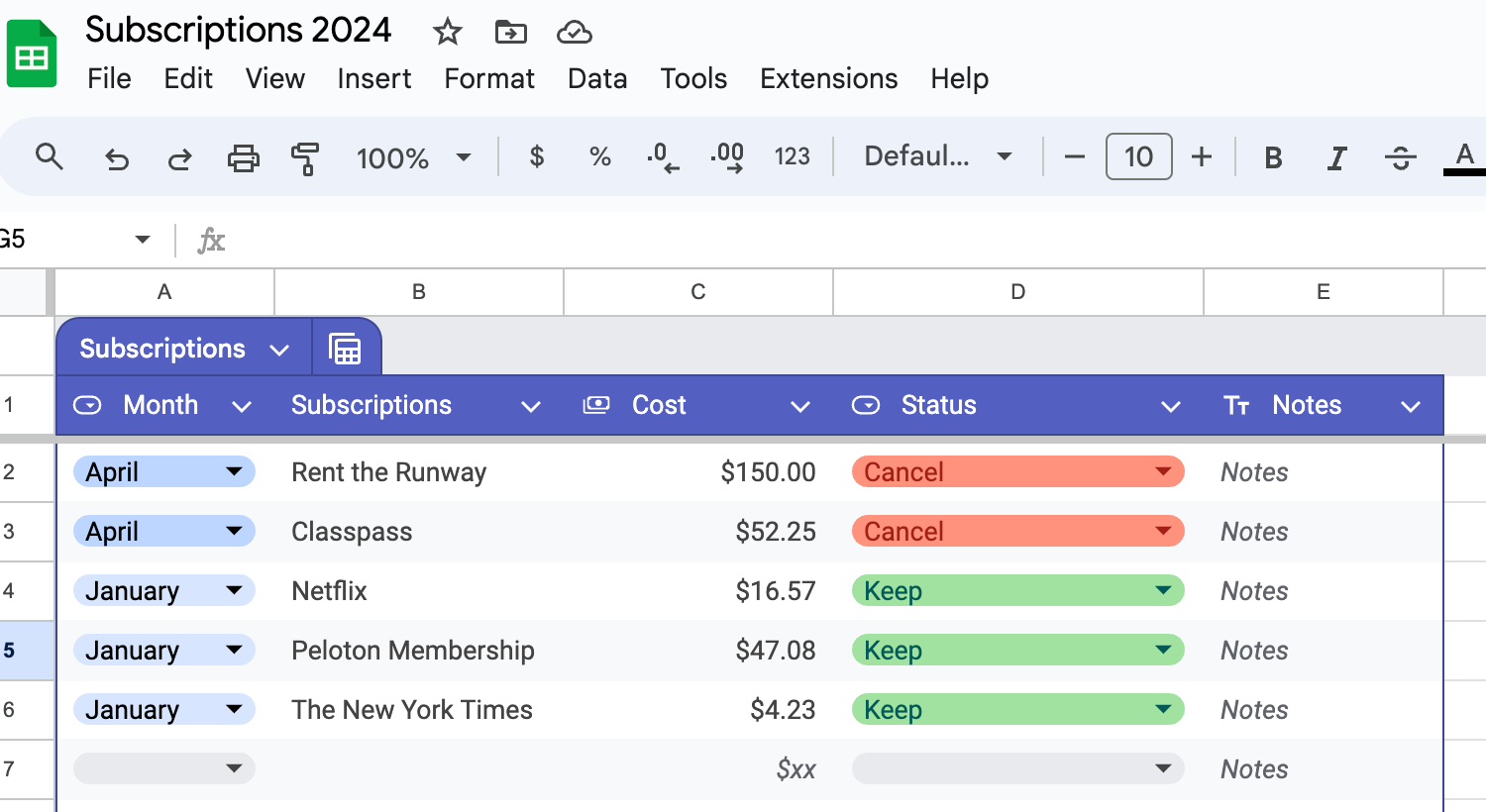I’m a personal finance reporter — here’s how I did a mid-year financial checkup in under an hour

When life gets in the way, it’s easy to put pesky but important tasks — like health and financial checkups — at the bottom of your to-do list.
But with the summer slowdown, it’s the perfect time to complete tasks you’ve been putting off — not just booking those doctor and dentist appointments but also scheduling a financial checkup with yourself. If there’s one thing that I’ve heard repeatedly over the last few years when speaking to financial experts for my job, it’s the importance of regularly checking in on your finances.
The beauty of a financial checkup is that it’s much easier than actual health checkups. You don’t have to spend hours at your doctor’s office or sit through a cavity filling. You can do it from the comfort of your home and it’ll likely eat into only an hour of your day.
I do a financial checkup every year, typically sometime in June or July, and I recommend that you do too. I’ve found that setting aside time to tune up my finances in granular detail is the most effective way to ensure my budget and savings are on track for the rest of the year. It also allows me to reevaluate my long-term financial goals, like saving for retirement, a house and more.
Here are five easy ways I checked on my finances in under an hour.
View this post on Instagram
1. Revisit my budget strategy. Is it working for me?
Time required: 20 minutes
Midyear is the perfect time to revisit your budget and make sure it’s working for you. I follow the 50/30/20 rule as a baseline for establishing my budget and find that it generally works for me. I make slight adjustments to the parameters here and there to suit my reality, depending on my salary and where I’m living. Here are the types of expenses I’m allocating to each category:
- Needs (45%): Housing, utilities, transportation, health care, groceries, household supplies
- Wants (25%): Travel, weddings, dining (takeout and restaurants), subscriptions, clothes and beauty products, manicures
- Savings and debt repayment (30%): Emergency savings fund, down payment fund, student loans
You can manage your budget in whatever way works best for you, whether that’s with pen and paper, online spreadsheets or a budgeting app. I used Google Sheets for years for budgeting, but recently made the switch to an app called Notion to manage my budget. My budgeting spreadsheet on Notion lays out my projected vs. actual income, expenses, debt and savings. Every line item is bucketed as a need, want or savings, which helps me visually see how much I’m spending vs. saving within each category. At the top of my spreadsheet, I also have specific percentages and dollar amounts allocated to my needs (45 percent), wants (25 percent) and savings (30 percent).
Here’s what I did:
When doing my financial checkup this year, the line items in my “needs” and “savings and debt repayment” categories within my budget looked good overall, but my “wants” category needed some work.
I noticed that over the last three months, I’ve been spending more than I’d like on subscriptions and takeout, which are two areas that I plan to immediately cut back on for the rest of the year. I also noticed I haven’t been spending as much on groceries. I rebalanced my budget accordingly, and I plan to reallocate what I’ve been spending on subscriptions and takeout — which total roughly $300 a month — toward groceries, my student loans and other short-term financial goals for the rest of the year, like my holiday shopping fund.
Doing a deep dive into my budget helped me better understand whether I was consistently overspending or underspending in certain areas, or if I had gotten into some less-than-desirable spending habits that I wanted to break. It also helped me figure out if I had been saving enough toward my longer-term goals.
A budget is an essential pillar of financial stability, and I highly recommend making one if you don’t already have one. Don’t know where to start? Take these 5 simple steps.
2. Check my credit reports for mistakes.
Time required: 15 minutes
Did you know that 1 in 5 people have an error on at least one of their credit reports? That’s according to a study conducted by the Federal Trade Commission.
I first encountered that statistic when I became a personal finance reporter a few years back, and ever since then, I’ve made it a priority every year to check my credit reports.
Keep in mind: Errors on your credit reports can bring down your credit score, which can impact your mortgage rates, credit card approvals, apartment requests and even your job. All of that can ultimately cost you money.
Here’s what I did:
I used AnnualCreditReport.com to get a free copy of my credit report from each of the three major credit reporting companies — Experian, Transunion and Equifax. It took me roughly five minutes to fill out the necessary forms, and an extra 10 minutes to flip through all of my credit reports.
The best part about checking my credit reports is that it’s completely free. If you find errors, you can dispute the errors at no cost to you with both the credit reporting company and the company that reported the incorrect information.
3. Manage my subscriptions.
Time required: 10 minutes
I have a tendency to sign up for subscriptions and forget to cancel them after the trial period is up or when they no longer serve me. So as part of my mid-year financial checkup, I decided to prune through what subscriptions I have and what I’m spending on them.
Here’s what I did:
To simplify the pruning process, I put together a spreadsheet that lists all the subscriptions I currently have, when they began, the monthly costs and any notes. Next, I went row by row and assigned a status to each one: cancel, keep or on the fence.
This exercise helped me spot any price increases or changes, which helped me decide if the subscription was worth keeping or not. Once I added all my subscription costs together, I realized I had been spending about $200 per month between April and June on subscriptions. That’s roughly $600 in total that I spent on subscriptions over three months. This was a big wake-up call for me, so I immediately canceled the big-ticket ones that I don’t feel I’m getting enough use out of to justify the price. I knew it would result in immediate savings for me for the rest of the year.
I didn’t need to use a subscription tracking tool or app, but if you’re juggling 10 or more subscriptions, I highly recommend using an app to help you stay on top of them — especially if they’re renewing monthly. Apps like Rocket Money and OneMain Trim can help you track recurring subscription payments, send alerts when prices increase and cancel unwanted subscriptions.

4. Start saving for holiday shopping and travel.
Time required: 10 minutes
An important part of my mid-year financial checkup is assessing my emergency savings and progress toward other short-term savings goals such as a vacation or a major purchase.
Money tip: I ask myself three questions when assessing my savings goals: Am I on track to meet the savings goals I set at the start of the year within the desired timeframe? Have my savings goals changed? What are my new ones?
However, my mid-year financial checkup made me realize I have another savings goal I need to prioritize throughout the rest of the year. That’s holiday shopping and travel.
Here’s what I did:
I don’t typically start saving for the holidays this early in the year, but I want to be more financially prepared for it this year. Many experts I’ve spoken to have said saving early for the holidays is the best way to prevent credit card debt or pulling those funds from an emergency savings account.
To get a headstart on holiday spending, I opened a high-yield savings account and set up a monthly automatic contribution of $150 from now through December. That’ll guarantee me at least $900 (plus any interest I earn) by the beginning of December to put toward holiday gifts and travel.
5. Boost my retirement contributions.
Time required: 5 minutes
I’m always looking for ways to boost my retirement savings in my 401(k) plan, whether by depositing a lump sum payment occasionally or increasing my contributions gradually.
The beauty of 401(k) contributions is that they come right out of my paycheck, so I don’t even miss that potential spending money. My next big goal for my retirement savings is to save 15 percent of my income annually by age 30, including any matching contributions from my employer.
Here’s what I did:
One of my tried and true strategies, especially halfway through the year, is to increase my 401(k) contribution by at least half a percentage point. I also plan to increase my contributions by at least half a percentage point at the end of the year. Though it might not seem like much, these small bits of cash can really add up over time. Contributing just half a percentage point to 1 percent more of your salary annually over a few decades can lead to hundreds of thousands of dollars more in your retirement savings, which will make a noticeable difference in your lifestyle in retirement.
For me, half a percentage point increase means I’m contributing an extra $30 per paycheck toward my 401(k) plan, which will lead to an additional $300 in my retirement savings by the end of the year, including my employer match. That may seem like a small number, but over time, those extra contributions will be worth a lot more — thanks to the magic of compound interest.
I try to remind myself that small steps now can turn into big strides later. Saving for retirement is a journey, and few people are able to save 15 percent of their income overnight. If you feel behind, don’t fret. Aim to save at least enough to get any match from your employer and work your way up from there.
The bottom line
Just like maintaining your physical health and your dental hygiene, you want to ensure your wallet stays healthy, too.
I make it a priority to keep tabs on my budget and savings every month, but even with all that, a more in-depth mid-year checkup helps me stay on top of things and re-examine long-term financial goals. Halfway through the year gives me enough time to pivot financially if I need to, and it’s the one thing that ensures I don’t ask, “Where did it all go?” at the end of the year.
My financial checkup also didn’t take up a lot of my time, roughly an hour in total. If you haven’t scheduled a financial checkup with yourself yet, take the time to do so. I promise it’ll be worth it.






